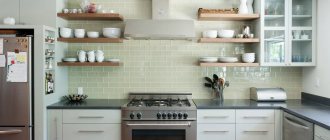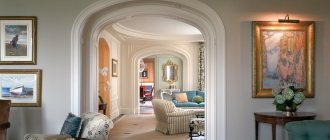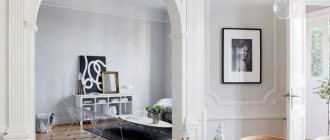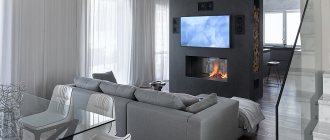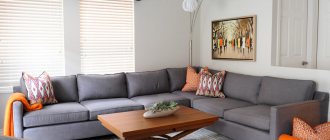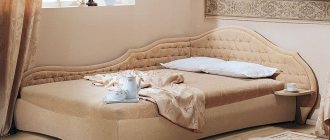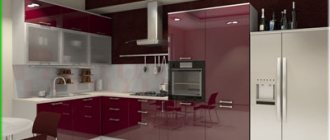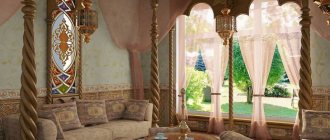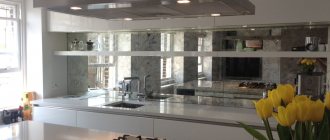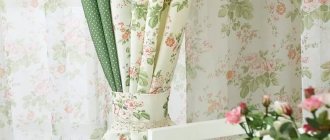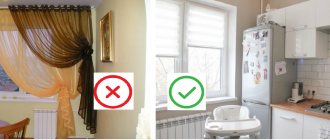If earlier columns in the interior were used only for practical purposes, as a base for the ceiling, roof, or next floor, today the situation has changed dramatically. A modern interior implies not only their functional purpose, but also a decorative one. In both cases, this structural unit has to fit into the interior of the room, and the technique chosen for this may be different and depend on many factors, which we will talk about.
Decorative columns in the interior Source www.stroydodyr.ru
Column located asymmetrically Source landshaftdizajn.ru
Marble column in the interior Source pinimg.com
Concrete column in the interior Source lepnina-oboi.com
Columns in modern rooms
In ancient times, columns served as supporting structures, and only later began to play a decorative role in the interior. The classic column consists of three parts:
- base - or base (lower part);
- trunk (central part);
- capitals (top part).
The bottom and top parts may sometimes be missing. The capital is the most decorative element of the column, decorated with elegant ornaments and regal bas-reliefs.
Modern columns can have the following design options:
- colonnades;
- paired columns (or united by one arch);
- semi-columns.
Paired columns are a classic option. They are usually located on both sides of the fireplace, window or staircase. Installation to opposite walls makes it possible to delimit the space, dividing it into functional zones. If they are united by an arch, this effect is enhanced.
Most often, paired columns have only a decorative function, participating in the design as an element that unites the space into a single zone, emphasizing the overall style.
Colonnades. This type of column is a great way to unobtrusively zone a space. If their location is determined at the construction stage, they can become a supporting structure, also carrying a functional load.
Half-columns - imitate columns protruding from the walls. The role in the interior is actually the same - creating a visual accent, zoning the room. It is very easy to frame a fireplace or window with them, fixing them against the wall, since they do not carry any functional load. They look no less expressive in the interior than traditional ones.
Interior design using columns can dramatically transform a room. With their help, it is easy to make a spectacular accent where it is needed.
Keep in mind that the shapes and sizes of columns significantly affect the perception of space. Tall, thin designs bring more grace to the interior, visually expand the space and increase the height of the room.
Thick ones, on the contrary, can visually make the room smaller. However, they give it fundamentality and create a feeling of strength and reliability.
Manufacturing materials
The choice of material for the construction of columns will depend entirely on their purpose and style.
- Stone and brick are very durable materials that will serve as a good basis for load-bearing elements. On the other hand, they have significant weight, so take this into account when choosing the number of columns and their thickness. In an apartment, it is necessary to correctly calculate the mass so that it does not go beyond the limits of the possible permissible loads on the floor slabs according to construction GOSTs. It is wise to design these support structures when building a new holiday home. If your goal is only to decorate the room, then use stone as a finishing material. Brick elements will perfectly complement an interior designed in a Scandinavian or loft style. Stone structures are suitable for a country-style room, while marble ones will perfectly emphasize the sophistication of the classical style. Small fragments decorated with stone will fit well into other styles, especially if they resonate with the decoration of the floors or fireplace area.
- Metal would be appropriate in modern interiors, for example, hi-tech style, kitsch or minimalism, the cold surface of metal with its characteristic reflections will perfectly complement the overall picture. You can play in contrast with the overall decoration of the walls and highlight the features inherent in the room.
Black or white matte surfaces look
especially unusual It is not necessary to make the entire structure from solid sheet metal; you can sheathe the frame with metal panels, which will significantly reduce the cost of the process. - Tree due to its versatility, strength and durability, it is used in almost all all styles for the manufacture of any elements. It is distinguished by its natural beauty and unique texture. Carved trunks and capitals decorated with various patterns testify to the good taste and prosperity of the owner of the house, because such elements cost a lot of money and are rightfully considered real a work of art. They can play both a decorative role and the role of load-bearing structures under light loads.
Classic style, country, Provence, Scandinavian, eco and others, where the use of natural materials is preferable, cannot do without wooden columns. Wood can be painted, you can simply open it with clear varnish, in any form it looks stylish and noble. - Concrete - Very lasting And durable material that will complement the feeling of incompleteness inherent in the style loft. Such an element does not even need to be subject to additional design.
In this case, two functions will be combined - decorative and practical. But you shouldn’t burden the room by erecting a concrete pillar just to emphasize one or another feature of the interior. Such elements are performed only if it is necessary to support load-bearing structures. - Drywall - a favorite material of many designers, which allows you to quickly and at low cost radically change and decorate the most boring interior. This material is good for its pliability, it can be veneer with any kind finishing materials. An undoubted advantage is light weight such structures.
To achieve visual appeal, it will be enough to finish the surface of the drywall with finishing putty and simply paint them. Well, if you show a little imagination and line the walls with artificial stone or gypsum bricks, you will not be able to distinguish such columns from those that are actually made of natural materials. - Polyurethane is white material It can be rigid and bend, which makes it possible to make structures of unusual shapes from it. Columns made of polyurethane are suitable for absolutely all styles. They are sold ready-made, in various diameters with a smooth or faceted surface. As a rule, for one pillar there are several options for the base and capital, which are already decorated with artistic bas-reliefs or other elements. There are also half-columns with the ability to select the necessary elements. This material goes well with wallpaper, and with decorative plaster, and with stone, and other materials with which you subsequently decide to decorate the walls. In a word - a win-win option for undecided people.
Art Deco
A style that combines features of baroque and antiquity, sometimes modern. The shape of the columns must be strict and the lines must be clear.
In the upper and lower parts they can be decorated with gypsum stucco (gypsum will successfully replace polyurethane). If we talk about color, white, the classic version, is preferable.
Style features
The columns are designed to draw attention to the most interesting areas of the interior. They should complement and favorably emphasize the features of a particular style, without contradicting it. There are particularly successful areas in which it is recommended to use these elements.
- Loft , as the main design style of the entire room, undoubtedly benefits from the use of columns as decorative elements. It is considered a projection of abandoned industrial premises, which assume the presence of supporting elements. They just have to look like rough, unfinished structures made from rough materials, such as metal, brick or raw concrete. Rough textured surfaces, a limited range of colors and strict shapes are the main features of elements made to match the loft style. Indeed, against the backdrop of such unfinished elements, modern equipment or furniture is perceived as a luxury item, which is what the performers need to achieve.
- Antique style involves the use of expensive natural materials, which are designed to emphasize luxury and splendor. This style is suitable not even for paired elements, but for entire colonnades made of natural marble, jade, and malachite. Of course, the cost of such a monolithic structure will go beyond all acceptable limits, therefore, in order to reduce the cost of the product, only cladding from these materials is used. The use of cheap materials is unacceptable in this option, otherwise you risk ruining the appearance and atmosphere of the entire room.
- Egyptian style is limited to a certain theme, which is conveyed to absolutely all objects in the room. The color range, as a rule, is also limited and includes blue, green, red and some of their shades, such as coral and olive. the surface of the columns can only be smooth and must be decorated with plant-themed ornaments. Textured and rough surfaces will contradict the chosen style.
- Baroque is one of the simplest styles for making columns. You can use materials such as gypsum, artificial stone or polyurethane. If you give preference to carved wooden columns, you can emphasize the luxury of this historical style.
- Modern involves the use asymmetrical shapes, which add originality, and thanks to the predominance of smooth curved lines, such columns in the interior attract attention and seem to hypnotize. Such elements will definitely not go unnoticed.
- Ethnic styles, which include Provence and country, are actually quite diverse. In such rooms, arches look very harmonious, and if you complement them on both sides with columns on which they will supposedly rest, you can make the space more open and interesting. Elements made of wood or brick will perfectly complement the interior.
- Classic assumes good materials and strict regular forms. This interior looks solid and expensive, but at the same time discreet and elegant. Wooden columns of regular shape, decorated with carved pillars or, conversely, smooth ones, but with bas-reliefs on the base and pilaster, are just right for such rooms. Wood is best used in its in its natural form, just giving it a slight tint using stain or opening it with clear varnish. This will make its natural shade more saturated and protect it from moisture and fading.
Retro
In this case, the finish will be rough, not luxurious. It can be natural stone or imitation, aged wood.
Interior doors in the house - which ones to choose? Review of the best models of 2022. 125 photos of new designs- Entrance doors to the house - which ones to choose? Review of the best models of 2022, design examples + 120 photos
8 by 8 house layout - the best design projects of 2022. Instructions for beginners + 100 design photos
Gypsum
Ecological, maximum resistant to temperature changes. During hardening, the gypsum mass becomes larger and even has the ability to penetrate small cracks. The plasticity of this material facilitates the workflow associated with plaster decoration.
Gypsum is not difficult to process, which is why it is not difficult to give the finished product the required size. When working with stucco from this material, you can mask surface defects, as well as various damage to elements that often appear during transportation.
Gypsum cladding also has its disadvantages: considerable weight, which negatively affects the durability of the finish. Also, gypsum does not repel moisture, but attracts it, which leads to the formation of fungus on the surface.
You can get rid of this drawback by applying a special protective agent to the stucco molding.
High tech
This style requires unexpected and original ideas. For example, futuristic ones: illuminated glass columns that are filled with liquid with air bubbles moving upward.
The main recommendations are to use metal, create shiny surfaces that reflect light.
Advantages of polyurethane stucco molding
Initially, stucco was made from gypsum. The products had a decent appearance, but their disadvantage was the presence of restrictions in use. Polyurethane stucco, unlike its ancestor, has a number of positive qualities, such as:
— High decorative properties with many design variations;
— Practicality – polyurethane is resistant to mechanical and climatic influences, due to which it can last for quite a long time (and after several decades it will not lose its original appearance);
— No signs of yellowing or shedding;
— Moisture resistance – the material is not afraid of moisture, so various decorations made from it can be placed in kitchens, bathrooms, as well as on the open facades of houses;
— Ease of installation work - to make decor from polyurethane stucco molding, you do not need a special set of tools. At the same time, if the decor is tired and requires replacement, it can be easily removed and a new one decorated.
In addition to the considered arguments, one can also note the low cost of the material, which allows anyone who wants to purchase decorative elements to fill their home with sophistication. As for the disadvantages, it is worth noting the weak resistance to high temperatures, as a result of which the material begins to melt, so you need to be extremely careful when placing the decor in fire hazardous areas (it is not recommended to install stucco above the stove).
Loft
Clear square and rectangular shapes would be appropriate here. Imitation of brickwork and concrete, rough plaster are suitable for decoration.
- Advantages and disadvantages of metal siding
TOP 5 popular myths about plastic windows
- We are building a house, what should we pay attention to?
Brackets, pedestals
As for the first elements, they are reliable supports for shelves with books and window sills. Can be installed at the junctions of wall and ceiling surfaces in the form of corner parts.
Pedestals are considered supports for decorative accessories. Such stucco can withstand a load of no more than 50 kilograms. Ordinary details placed on a pedestal look exclusive and meaningful.
When installing such parts, it is important not to forget about their proportionality in relation to the size of the room. Massive stucco molding on the wall surface will visually narrow the room, and on the contrary, small stucco molding can easily get lost in a large space
Interesting design ideas
In order for the column to successfully blend into the setting, becoming part of the whole picture, sometimes creative solutions are needed
- current technique is a combination of rough stone finishing with soft materials;
- columns installed nearby can easily be converted into a homemade shelving unit;
- using columns, you can create a niche to place a TV or music center;
- with properly equipped lighting, you can highlight a decorative niche inside where a painting, antique dishes or sculpture will be located;
- You can delimit the space even more effectively by placing a cabinet or rack between the columns.
Use your imagination to use this interior detail as profitably as possible. Modern possibilities allow you to decorate your home based on any taste preferences.
Disguise
This technique will help when the columns in the interior of the room occupy an inappropriate place, that is, it cannot be used for another purpose (dividing the space, displaying it as an elegant element that emphasizes the stylistic direction, using it for another purpose). In this case, there is only one way out - to make it as less noticeable as possible against the general background. There can be several methods for this:
- Lined with mirrors, it will blend in with the rest of the interior and will not be so conspicuous.
- Finish with the material used for the walls.
- Hide behind a curtain, curtain, screen. This can be easily accomplished by choosing a volumetric material suitable for the interior.
Advice! The technique is most often used to “hide” one column. Carrying out a similar procedure with two or more can be problematic.
Zoning
If positioned well, a decorative column can be used as a space delimiter into zones with different functional characteristics. This method will have an additional number of advantages , which were already mentioned earlier:
- The columns do not obstruct the light coming from the windows.
- They do not occupy free space in the room.
- They free the space from the clutter of partitions, making it more spacious and bright.
Accenting
Use as a decorative element is an excellent option for how to use columns in the interior. There are many ways to implement your plans. The basic rule is to choose the right material and method of cladding that blends favorably with the rest of the room’s design.
One of the options for executing the plan could be decor using finishing materials and attracting attention with the help of artificial lighting.
For example, install a lamp at the bottom or top of the element. The only thing that needs to be taken into account is that the light saturation should not be excessive. It is not necessary to illuminate the entire surface of the column; it is enough to direct the beam at one of the protruding faces.
This technique is beneficial regardless of its shape, rectangular or rounded.
Practical use
In addition to aesthetic functions, decorative columns can also play a practical role. In particular, they are easy to adapt to specific needs, combining beauty and style with needs. There are many options for execution. Let's look at a few of the most popular solutions:
- Use it as a place to place the TV.
- Organize a magnetic or slate board on it, which will be useful to every family member, and especially children.
- When the column is located next to the wall, away from the passage area, it can be used to easily fix the hammock. This method will turn this area of the room into a full-fledged place to relax.
In a similar way, you can use it as one of the points for supporting the fastening of other built-in furniture (kitchen island, bar counter, dining table).
- Arrange a plasterboard structure around it and make niches for storing books, photo frames and other decorative elements.
Important! The need to construct support columns most often arises during the construction of a large country cottage. In this case, you can take care of the location problem in advance and build the project in such a way as to use them profitably in the future.
Styles
Columns can be used in different interior styles. The most popular, of course, is the classic one. Here you need to choose natural materials, and the best option, of course, is wood. The style supports strict and regular forms, smooth lines. Products can be either smooth or with patterns. The carved bas-reliefs and richly decorated capitals look very interesting.
In addition to the proven classics, columns have found their place in many stylistic directions.
Modern style
Most modern styles involve minimalism and functionality. Columns should not stand out from the overall interior design. The best materials will be plasterboard, polyurethane, mirror finish, acrylic glass. Pretentiousness must be completely removed: such columns should be strict and laconic.
Art Deco
This is a style in which antiquity is successfully combined with modern trends, as well as baroque. Therefore, columns in this direction should be strict, restrained, preferably white or ivory, but decorated. In most cases, gypsum stucco is used as decoration.
Baroque
Baroque is a pretentious, somewhat pretentious style that suggests wealth and luxury. For it, you should select spectacular columns from expensive materials, for example, stone or marble. In addition, the structures should have a beautiful decor, and the capital should be especially richly decorated. The use of patterns and gold paint is encouraged.
Retro
This style involves the use of contrasting shades, expressing a protest against gray and dull everyday life. The most common colors are black, white and red.
High tech
The high-tech trend with its chrome-plated cool shine has recently been chosen by more and more apartment owners
If we talk about columns that will suit this style, it is important to note metal structures or models covered with metal panels. They will successfully complement the overall design of the room
In addition, acrylic glass will look good.
Loft
In the loft style, columns will be one of the most interesting solutions. This is where concrete structures would be appropriate, creating the impression of incompleteness, which is typical of the style. Brick pillars look no less creative. The main thing is to create the illusion of carelessness, slight abandonment. It is better to choose restrained tones from the colors: gray, beige, but brown colors are also welcome.
Provence
Columns in the Provencal style should be light and airy. Available shades include white or ivory.
Decorations should be few, but they may occur. For example, columns in the Provence style can be beautifully decorated with flowers.
In addition to the directions already described, columns can be used in other styles:
- antique;
- Egyptian;
- modern;
- country;
- Empire style
Era? Style? Direction?
Noble classics
The classic interior with antique columns is based on Greek samples - Doric, Ionic, Corinthian styles. The decoration of the base, body, capitals not only has not changed, moreover, good taste requires strict adherence to Greek ideals.
Antique Greek columns and half-columns are harmoniously combined with modern multi-level ceilings, lighting, and polyurethane stucco molding. Decorating columns with Venetian plaster, marbled painting, and natural stone is widely used by decorative artists. Columns are made from inexpensive materials - polyurethane foam, gypsum, concrete, and then richly painted. This significantly reduces their cost and simplifies installation.
Modern designers especially liked the combination of two or more columns connected by an arched bend. Arches, in order to reduce the cost and lighten the structure, are made of plasterboard. The same style includes rectangular wooden columns, decorated with expensive types of wood in the style of an English office or a Russian mansion, together with wooden panels on the walls.
Mysterious east
Impressive colonnades connected by arches are an integral element of oriental architecture. In contrast to classical restraint, the body of the eastern column is richly decorated with mosaics, ornaments, and bright colors.
Arched curves are emphasized by additional lines and are also richly and brightly lined. Architectural ensembles with columns in oriental interiors are complemented by fabric draperies, carpets, and stained glass windows.
Modern interior trends
Minimalist style, hi-tech, loft – the columns have not been spared. These styles require large free space and significant height. The columns here act as floor supports. Most often, these are simple pillars, finished in accordance with the style of the room - metal (silver, nickel, chrome, copper), clinker “looking like aged brick,” concrete with traces of formwork. The latest trend is the use of lighting in glass columns with bubbles.
Country styles
In the good old Provence, Russian rustic style, and other ethnic styles, wood and rough natural stone are preferred for decorating columns. Columns can be entirely wooden, and “stone” finishing on various bases (concrete, polyurethane foam, plasterboard, false column) is done with materials that imitate stone.
